33 Best Meats for Backpacking that Taste Great
I love backpacking. Both in the United States and abroad. After college I hiked sections of the Pacific Crest Trail and hike on the Appalachian trail regularly.
Backpacking is an adventure pure and simple. It allows you to immerse yourself in nature, challenge yourself physically, and disconnect from everyday life.
The best meats for backpacking are shelf stable, nutritious, and delicious. But some meats are much better than others when you consider important stuff like weight and durability. When it comes to food, packing light is ESSENTIAL. You don’t have the space.
That can be quite a challenge on the trail. You need food choices that don’t spoil quickly, yet provide you with the energy needed to keep you going. This food should also taste good.
That’s where meat comes in. Meats are a great source of protein and essential nutrients. They also have high caloric density. Crucial for maintaining energy levels when you have to spend all day going straight uphill.
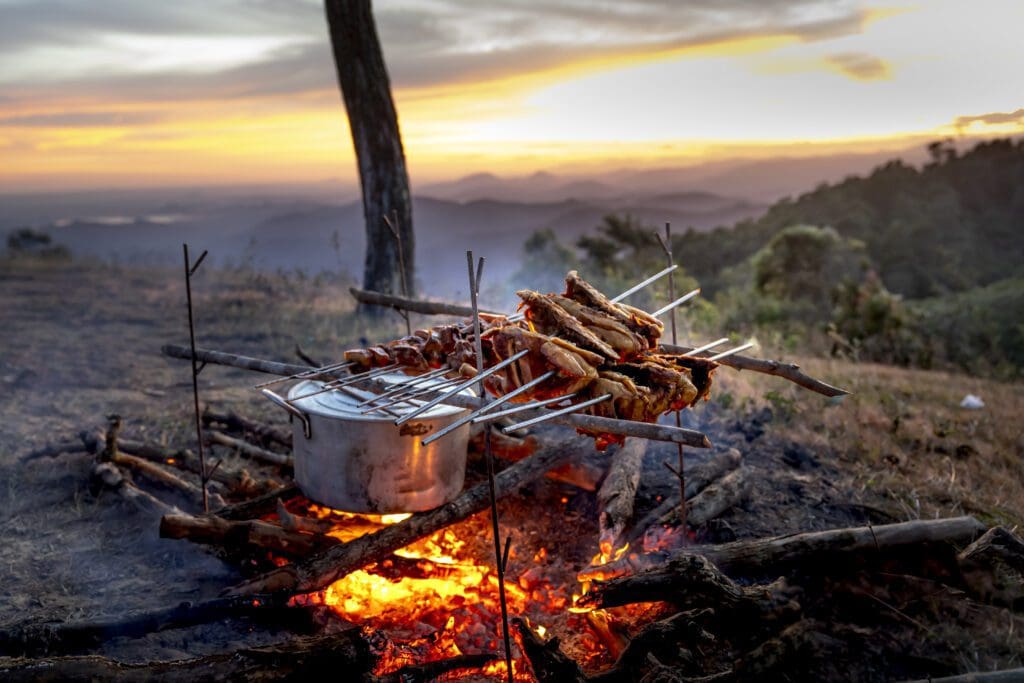
I’ve assembled 33 meats for backpacking that will help you go that extra mile on your next backpacking trip. Many of these meats can stay at room temperature. You can pick them up in almost any grocery store, like Trader Joe’s or on Amazon. So read on and munch away!
33 Best Meats for Backpacking:
1. Smoked Salmon:
Smoked salmon is a great option for summer backpacking trips. It’s high in protein and healthy fats and doesn’t require refrigeration. I absolutely love smoked salmon for it’s rich umami flavor. While it’s delicious on it’s own, you can also eat it with crackers, on bread, or add it to a pasta or rice dish! So many amazing options.
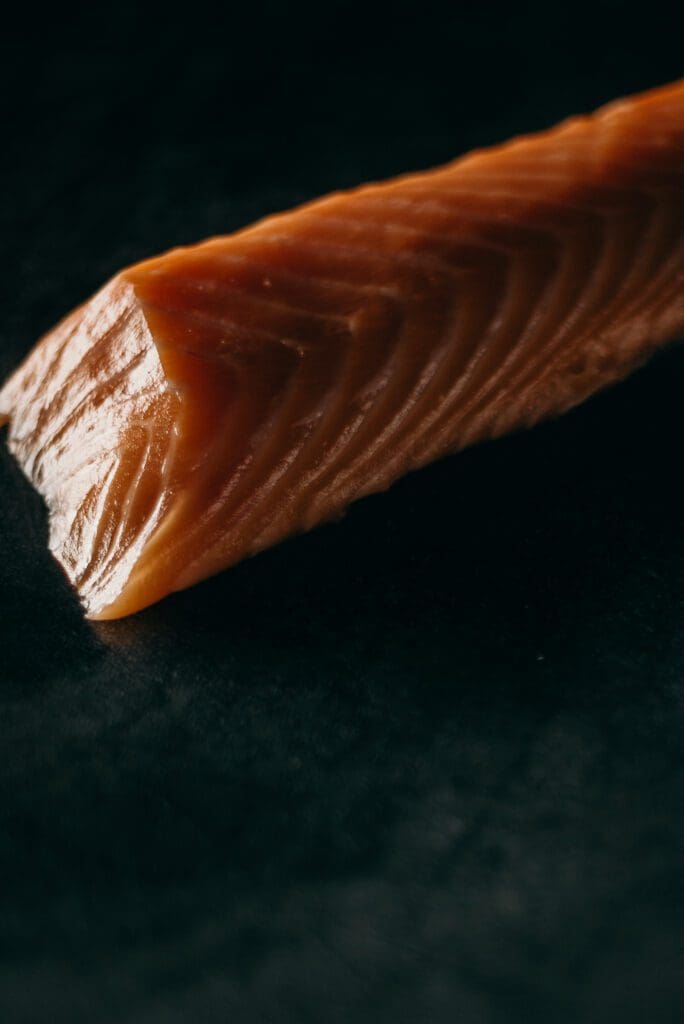
2. Summer Sausage:
Summer sausage is a great option for hikers looking to pack in much-needed calories during a day hike. This cured meat is rich in protein and fat, providing a great source of energy for extended outdoor activity.
You can eat summer sausage in a sandwich, on it’s own, or pair it with crackers and cheese for a delicious trail meal. While it’s easy to pack and requires no refrigeration, it is heavier than some of the other options so it might not always be the go to choice for longer backpacking trips.
3. Beef Jerky:
This is perhaps the most well-known and beloved meat snack amongst hikers and backpackers. This shelf-stable meat has a very long shelf life and can be stored in a backpack for long periods of time without spoiling.
Made from lean cuts of seasoned beef, it’s high in protein and low in fat. There is a reason beef jerky is the go-to choice for many backpackers. It can be eaten as you walk, or on a quick water break. It can also be thrown in other foods for a little added texture and protein boost!
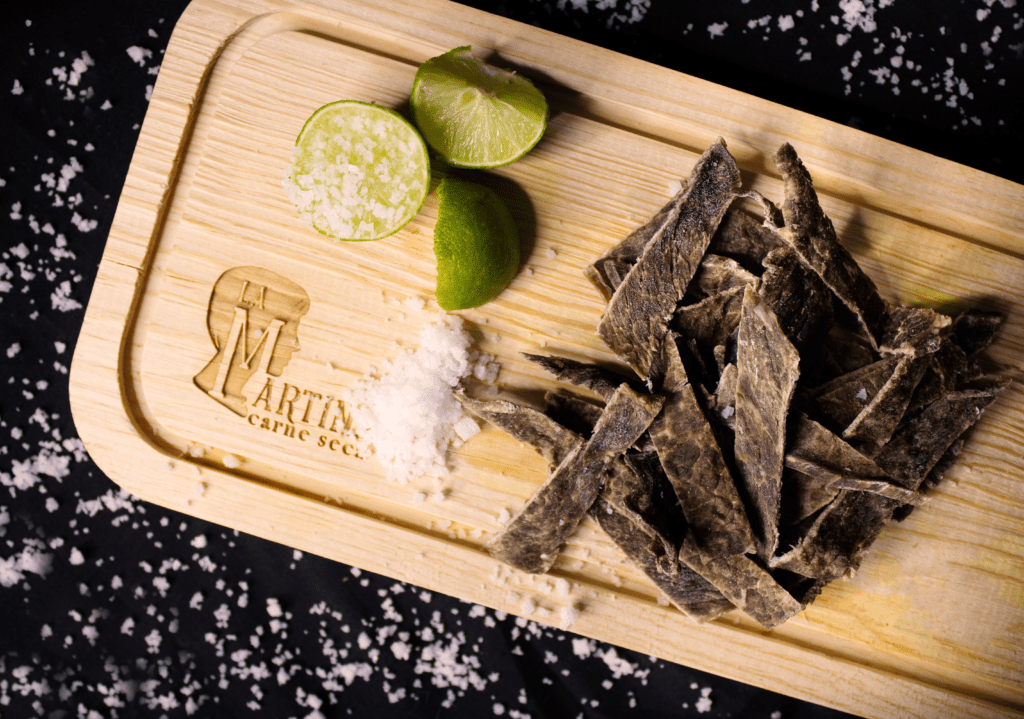
4. Pepperoni:
Pepperoni is a great way to add some variety to your backpacking meals. Classic pepperoni is made from cured pork, but there are other types of pepperoni too like turkey pepperoni and even plant-based pepperoni.
Because pepperoni has spices like paprika and garlic, it’s an awesome way to add some flavor to your food without a lot of extra weight or effort. Make a backcountry pizza on a tortilla or add it to a pasta dish for a kick of flavor.
5. Dry Salami:
It doesn’t matter whether you’re a seasoned backpacker or a first time hiker, you have probably already thought about dry salami as one of the best meats for backpacking. This tasty cured meat is shelf-stable and requires NO refrigeration.
It’s also high in protein and fat, so you’ll get that quick burst of energy needed to summit the mountain. I haven’t cooked a lot with dry salami but it’s excellent by itself or as a pre-meal appetizer while you’re waiting for that Mountain House to hydrate.

6. Dried Fish:
While not super popular in the United States, dried fish is very popular in other countries. This protein-rich, low fat food is made by air-drying fish – typically cod. It’s got a long shelf life and is a great option for backpackers looking for a nutrient-dense, lightweight food.
Vikings have eaten dried fish for centuries. In fact, we talk about dried fish in our article titled “Greatest Icelandic Foods You’ll Want to Feast On.” The Icelanders eat theirs with butter. So whether you’re exploring Iceland’s rugged wilderness or backpacking across the United States, dried fish could be a good addition to your meal plan.
7. Prosciutto:
I think prosciutto is one of the best cured meats that can be found in most grocery stores. This Italian dry-cured ham is salted, air-dried, and aged for several months. This results in a tender meat you can enjoy on it’s own, or add to a sandwich or salad.
It’s rich in flavor and will definitely elevate your trail cuisine. It often needs to be kept at lower temperatures though so check on the type of prosciutto you’re getting to make sure it holds up to your expedition.
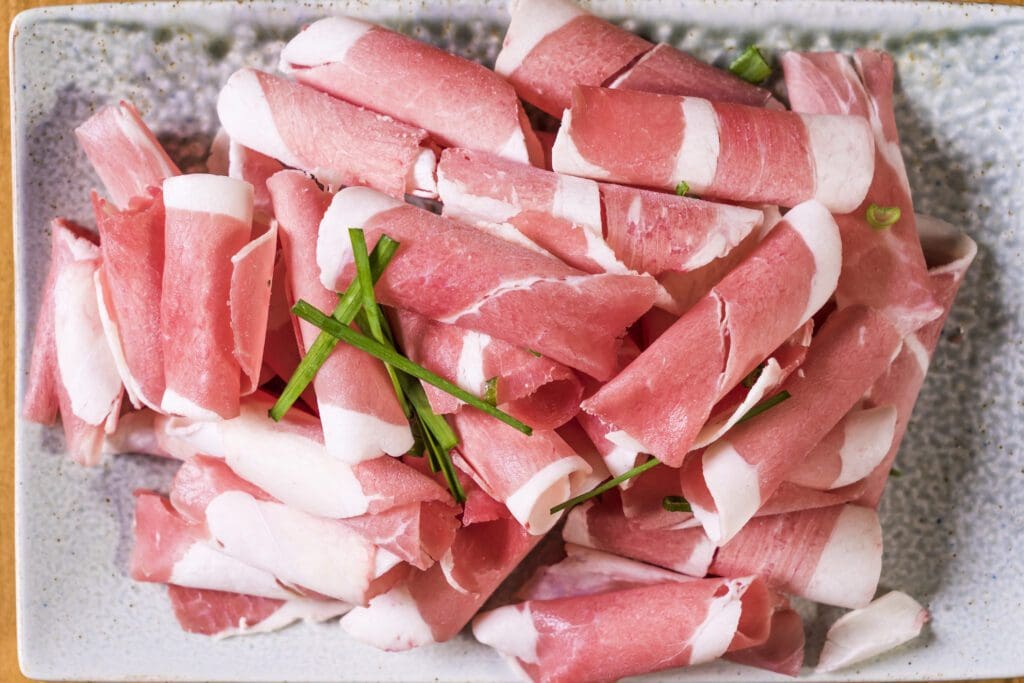
8. Pre-Cooked Bacon:
When I think of bacon, I think of trail breakfasts. A crispness in the air and a hot cup of coffee.
Pre-cooked bacon allows you to quickly and easily cook yourself up a filling breakfast before putting some miles under your feet.
Because it is one of those shelf stable meats, you don’t have to worry about keeping it cold. It’s also very lightweight so it’s not too troubling to pack.
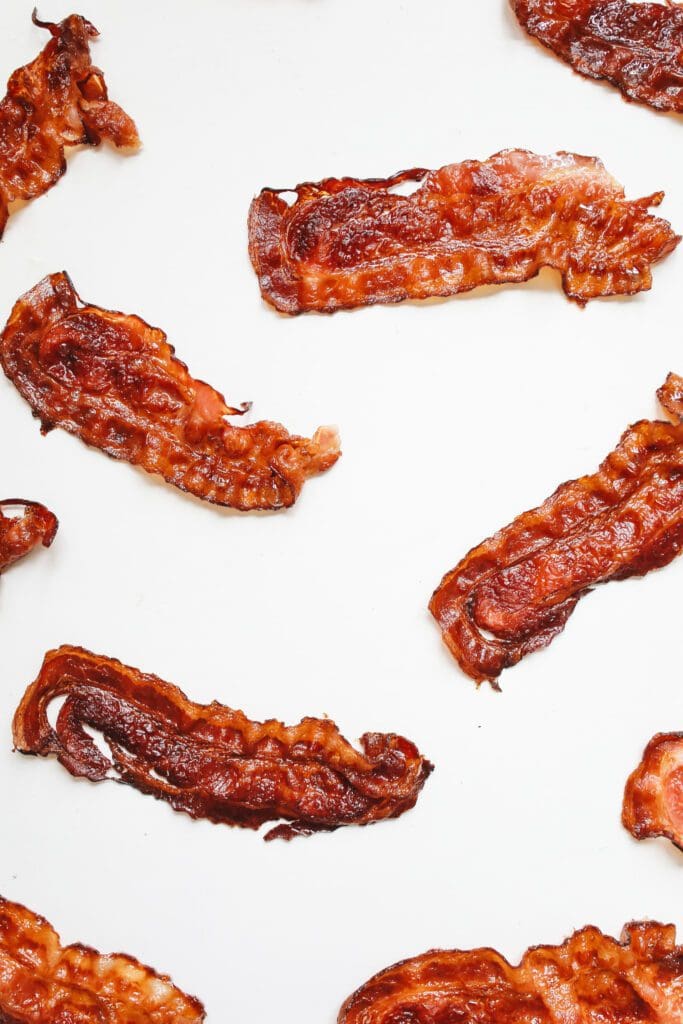
9. Bacon Bits:
Bacon bits are a great starting point to incorporate more meat into your trail meals. They’re small, light, and easily sprinkled onto various dishes from eggs, to pasta, to freeze-dried meals.
Their long shelf life mean you don’t have to worry about spoilage. And they pack a punch in flavor. Unlike prosciutto, they’re also very inexpensive.
10. Dehydrated Meats for Backpacking:
Dehydrated Meats (not to be confused with freeze dried meats) are a popular option when exploring meats for backpacking.
They’re lighweight, nutrient dense, and don’t require refrigeration. The drying process removes all the moisture which makes it shelf stable AND intensifies flavors.
Instead of buying meats for backpacking, make your own! To make your own dehydrated meat, all you need is a food dehydrator, some high quality meat, and a Ziploc bag.
You can experiment with different cuts and seasoning blends to create your own recipes. Or find recipes online people have already perfected like this one. Dehydrated meats for backpacking are also a great addition to trail mix, soups, and stews.
But yes, it is good as a snack by itself. If you plan on backpacking a lot, a food dehydrator is a cost-effective way to make some great tasting, light weight, backpacking meals.
11. Canned Salmon:
Canned salmon (or salmon fish pouches) are super convenient, low fat, and protein packed. It’s also a great source of omega-3 fatty acids which are good for heart and brain health.
When it comes to backpacking, the salmon pouches are definitely the way to go so you don’t have the weight and you don’t need to carry a can opener. You can mix canned salmon into rice or roll it up in seaweed wraps for trail “sushi”.
12. Canned Tuna:
Canned tuna is a staple for many backpackers because tuna pouches are so dang convenient! The best thing about canned tuna is its versatility. It can be used in so many ways to create satisfying meals.
Tuna pouches these days are served in so many different ways. Flavors like lemon pepper, ranch, buffalo sauce, and thai chili ensure you’ll never get bored. You can add it to rice or pasta and have yourself a great backpacking meal, or pair it with crackers for a great trailside snack.
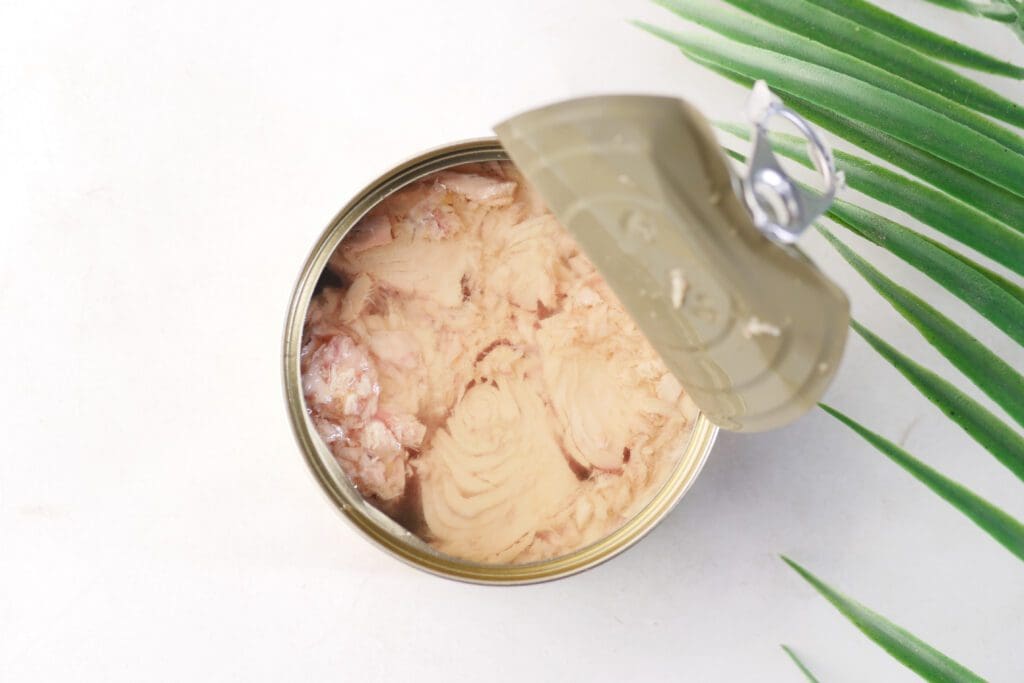
13. Freeze Dried Meats for Backpacking:
Freeze-dried meats like ground beef, freeze-dried chicken, pork, and other types of freeze-dried meats have become increasingly popular amongst backpackers due to their lightweight and easy-to-pack nature. You can get freeze-dried meats in bulk on Amazon.
You can then make your own recipes. Just mix the freeze-dried meat with salt and spices and other freeze-dried foods (rice, veggies, etc).
Mix it up and put them in a sturdy plastic bag. You can rehydrate them with cold or hot water on the trail. It’s cheaper than the individual packets but you still get all the pack weight benefits. If you rehydrate with cold water, you can eat it cold or heat it up on a pot in the backcountry.
14. Canned Chicken:
Canned Chicken is on our meats for backpacking list because it is a quick and easy protein option for backpackers. Again, don’t use the cans, just get the foil chicken packets. They are much lighter.
Canned chicken is affordable and available in most grocery stores. You can use mayo packets to make a chicken salad, or add the chicken to soups you make on trail (bouillon, water, chicken). If you’re not a fan of canned fish, you might try out chicken and see what you think.
15. Duck Jerky:
Of the various meats for backpacking, duck jerky is more expensive and harder to find that beef jerky. With that said, it’s flavorful and filled with protein. Like other types of jerky, duck jerky is a dry meat with a long shelf life. It’s lightweight and good for a snack. It’s got a chewy texture and is somewhere between beef and turkey jerky.
16. Vienna Sausages:
Alright alright, I can hear all the Vienna Sausages haters coming out of the woodwork right now. But nearly every grocery store and even gas stations have Vienna sausages – so someone has to be eating them.
They’re basically like canned mini hot dogs and plenty of people grow up eating these. You can add them to pasta, eat them with saltines, and kids like them.
While you may worry about letting your hiking buddies catch you with a can of Vienna sausages in your pocket, I say Hike Your Own Hike.
If Vienna sausages are your thing, carry on. Besides, there is an entire reddit community devoted to ways to prepare them. Embrace the Vienna sausage and enjoy your hike!
17. SPAM:
While you’re on a canned meat products roll, how can we forget about SPAM. It comes in foil packets as well as cans. SPAM is one of the most popular dishes in Hawaii. It’s served in McDonalds there. Why? It’s versatile and tastes great fried.
SPAM is great for breakfasts on the trail and can be used as part of a ham sandwich or the Hawaiian way – SPAM and rice. So don’t discount this classic meat product when it comes to stocking up for your next backpacking trip. You just might become a die-hard SPAM fan swearing by its savory and salty flavor!
18. Pemmican:
If you’re looking for a traditional backpacking food that’s been used for centuries, look no further than pemmican. Pemmican is a mixture of dried meat, fat, and berries. It was developed by Native Americans as a high-calorie, nutritious food that could sustain a human on long journeys.
I like to think of it as the original trail mix. Pemmican has a long shelf life and can be made at home with a few simple ingredients. It’s low carb, medium protein, and high fat.
Of this list of meats for backpacking, Pemmican is older than almost everything but smoked meats. Pemmican is a time-tested backpacking food that’s got excellent nutritional value and enough calories to keep you going, consider making some pemmican.
19. Meat Bars:
Protein bars or energy bars have grown in popularity amongst the outdoor travel community. Meat bars however, are relatively new to the stage. It’s more savory than other protein bars.
Of the meats for backpacking, it’s one of the easiest to eat. And it’s made entirely of meat like bison, beef, or turkey. So they’re obviously packed with protein.
You can find them in a variety of flavors like teriyaki or spicy. Meat Bars can be purchased online, at REI, or even at Whole Foods or Trader Joe’s. One great thing about meat bars is they’re filling with absolutely no cooking required. This makes it a quick, tasty, and easy lunch.
20. Biltong:
If you haven’t heard of Biltong, let this be your introduction. It’s a South African style dried meat and an excellent alternative to beef jerky. Before being air dried, Biltong is marinated in spices and cured in vinegar.
This make the meat very flavorful and tender. The unique preparation gives it a very distinct taste and it’s definitely worth trying out. You can find biltong in specialty stores or online. But if you have a food dehydrator and a little talent in the kitchen, you can make a version at home.
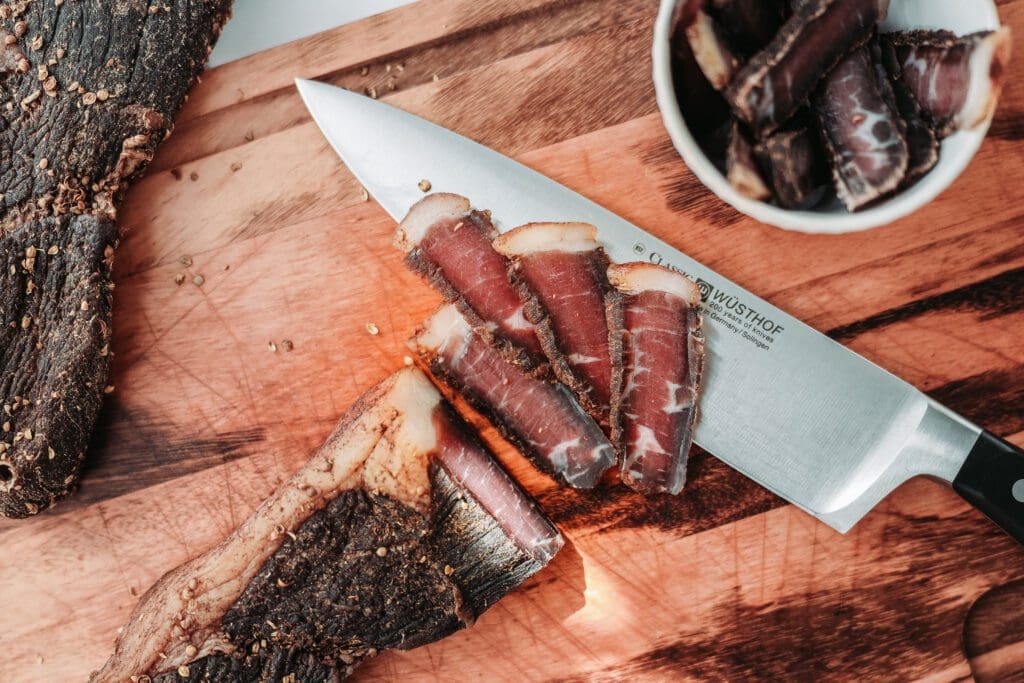
21. Salmon Jerky:
Meats for backpacking can often get an unhealthy rap, but that’s not the case for salmon jerky. Salmon jerky is made from lean cuts of salmon that are seasoned, dried, and smoked to perfection.
It’s a healthy and delicious snack for your next outdoor adventure. If you prefer seafood, salmon jerky is a great alternative to the land-based meats.
22. Chorizo:
Chorizo can be another fantastic choice when deciding meats for backpacking trips because it’s flavorful and shelf-stable. Made from ground pork, chorizo is a blend of spices like coriander, garlic, and chili powder.
It adds a savory kick to any dish and is great for breakfasts or dinner. You can add it to pasta sauce or scrambled eggs. Just remember to wrap it up in a paper towel to absorb excess oil as chorizo can get kind of oily.
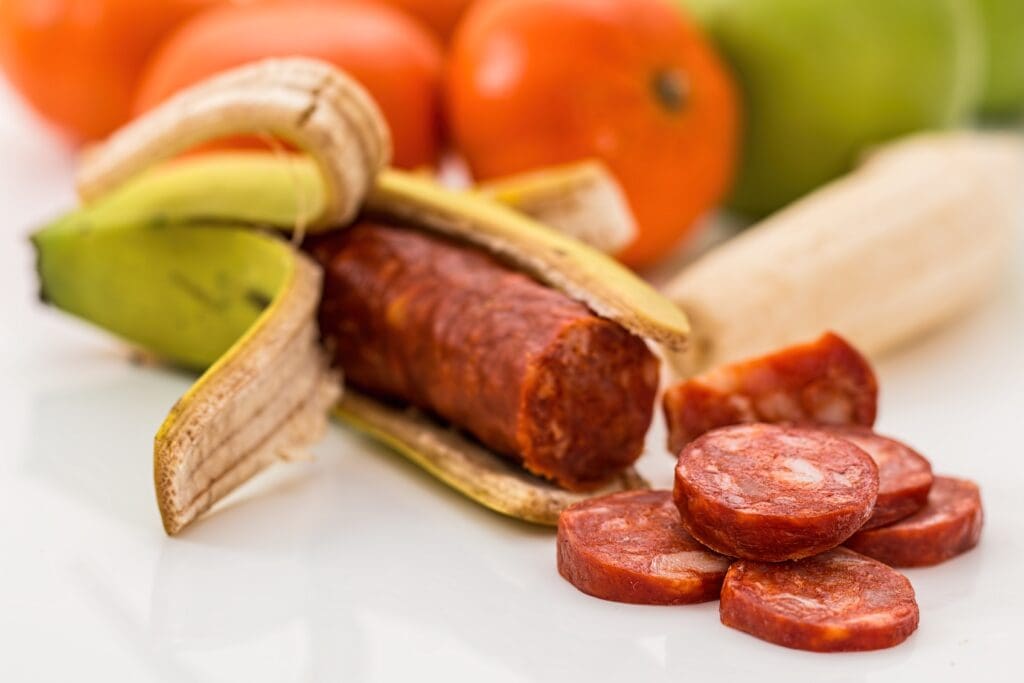
23. Dried Shrimp:
I know it sounds ridiculous but dried shrimp is the ULTIMATE backpacking ingredient if you want to add some serious umami to your meals. These little crustaceans don’t seem glamourous, but they pack a punch when it comes to flavor.
You can mix them with rice or boil them with bouillon cubes in hot water to make a flavorful broth. They’re just a great addition to any meals. While the smell can be a little odd for the uninitiated, the taste is oh so worth it. Trust me.
24. Pork Rinds:
Pork rinds, also known as chicharrones, are a good option for backpackers looking for a crunch and savory snack. These crispy fried pork skins are high in protein, low in carbs, and reminiscent of potato chips.
While they are very light, they can be pretty bulky, which makes it challenging for backpacking. They also can get smashed on a long hike. This isn’t necessarily a bad thing though, just use them to coat the SPAM and fry up a trail schnitzel!
If you’d like to keep your pork rinds whole, just put them in a Tupperware.
25. Canned Sardines:
Canned sardines are another potential option on the trail. You can put them on crackers or bread, and they come in all sorts of different flavors.
If you’re a fish fan and have yet to try canned sardines, I think it’s worth exploring. There are some great recipes online.
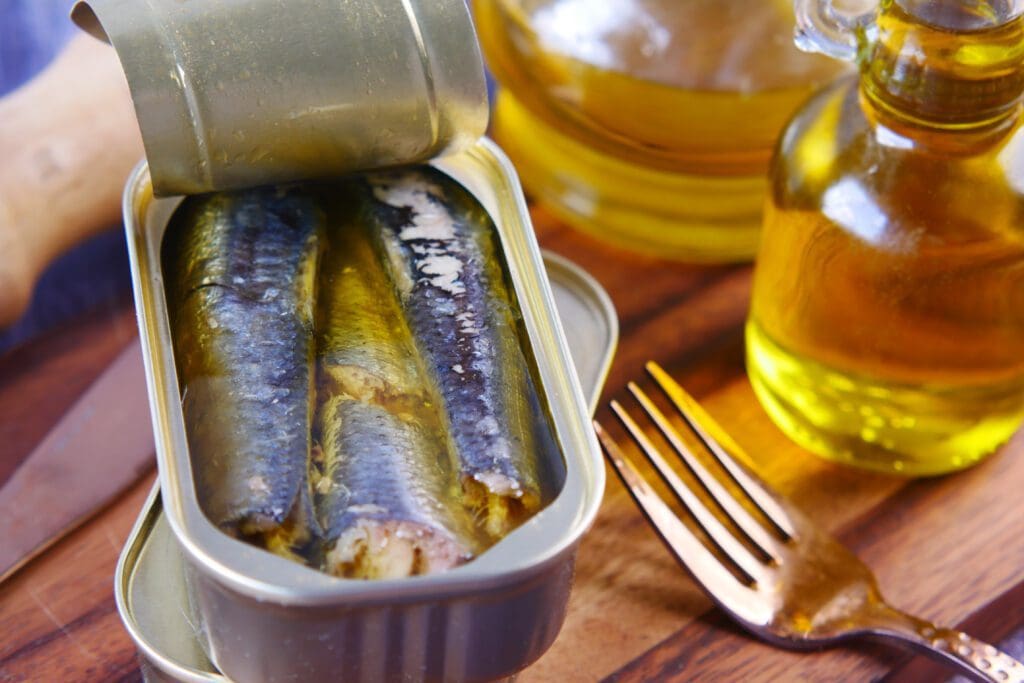
26. Soppresatta:
Soppressata is a traditional Italian cured meat and a great addition if you’re looking for meats for backpacking. It’s high in fat and protein and perfect for a snack at the summit with some wine and a loaf of french bread.
27. Calabrese:
Calabrese salami is one of the best meats for backpacking. It’s a dry-cured Italian sausage known for its bold and spicy flavor. We’re talking fennel, garlic, red pepper flakes and black pepper.
One of the good things about calabrese is they chewy texture. It’s similar to pepperoni and definitely a versatile trail food that can fuel any adventure.
28. Bier Sticks
If your hunt for meats for backpacking continues, check out Bier sticks. Bier sticks are small, flavorful sausages that are a good source of protein. They’re originally from Europe, and almost look like a really high quality slim jim.
29. Canned Corned Beef:
Unfortunately, I’ve yet to find any canned corned beef in foil packets. If your luck is similar to mine, that means you’ll likely need to pack out the can – which is extra wright. As such, canned corned beef might not be the best option for longer backpacking trips when ounces matter.
But if you’re on a short weekend trip, it can still be a delicious option. Just be sure to follow leave no trace principles!
If you haven’t had canned corned beef before, try and fry it up with some potatoes for a delightful hash!
30. Smoked Meats:
Smoking meats is one of the oldest preservation methods known to man. If you’re into smoking meats, this can be a wonderful method to preserve your meats for backpacking and keep them fresher for longer.
Smoke adds a rich flavor that always seems to taste better on a trail. Smoked turkey, beef, and of course salmon, are all popular choices. I’ve also met hunters who smoked elk or deer and took the meet with them on hikes.
Remember, smoking alone isn’t enough to keep meat fresh so be careful with the method you choose and make sure you’re doing everything safely.
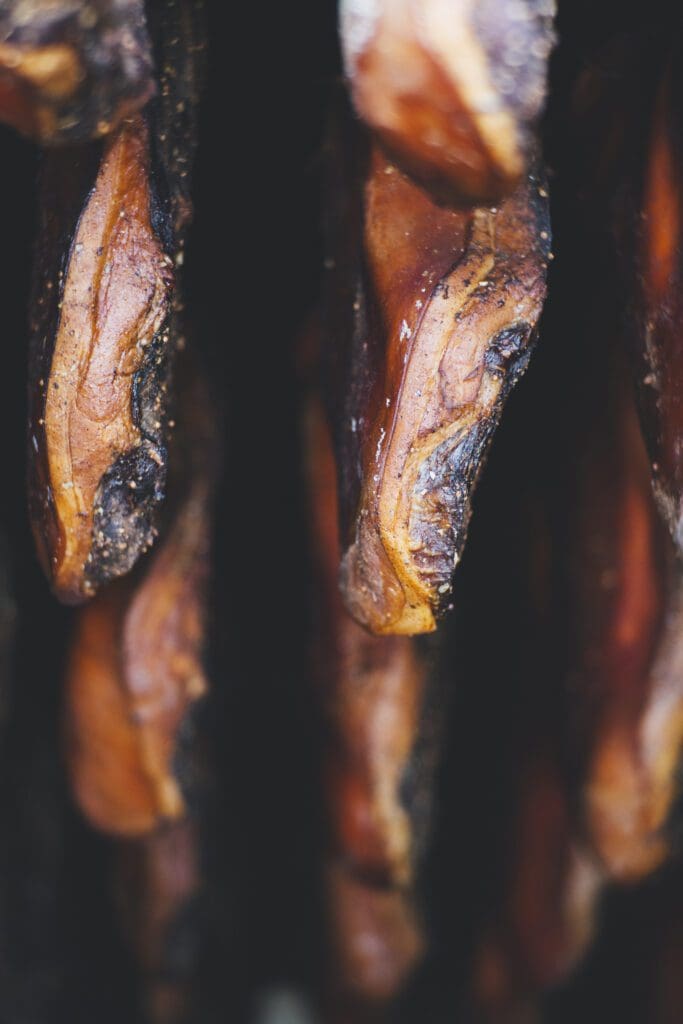
31. Backpacking Meals with LOTS of meat.
Freeze-Dried backpacking meals with LOTS of meat can also be purchased online. While these trail meals can be expensive, there are a number of companies that make their freeze-dried meals with extremely high quality ingredients.
One of my personal favorites that I eat on many of my adventures is Next Mile Meals. These low carb, high protein meals are so good. It’s hard to tell they were originally freeze dried. I love wrapping their breakfasts in a low-carb tortilla or their meatball marinara is maybe my favorite backpacking dinner.
Other great companies that provide meats for backpacking in their meals include Packit Gourmet and Backpacking Chef. Both have a wide selection of meat forward recipes. And because we all know people with dietary restrictions, the Outdoor Herbivore offers some good plant-based options with plant-based meat. Outdoor Herbivore also has gluten free meals.
32. Smoked Oysters:
Smoked Oysters can be thrown in a soup, or smeared on a cracker with some hot sauce. They’re typically steamed fresh and then packaged in olive oil. Once you pop open the can though, they can definitely be a little fragrant when you’re in bear country. And you’ve got to pack out the can again. But they are Oh. So. Good.
33. First-Night Meats:
What is a First-Night Meat*? It’s the meat you eat on the first day of your backpacking trip of course! It’s the one night where you can indulge in some fresh meats without worrying too much about refrigeration.
Fresh foods typically don’t stay good for more than a couple days and it’s important to handle raw meat and/or cooked meat carefully.
But on the first night, you can pack it with ice to avoid food poisoning and keep it at a lower temperature. The best way to do this is to freeze Nalgene bottles and use them as ice packs. You can also just fill up a ziploc with ice cubes and dump out the water on trail.
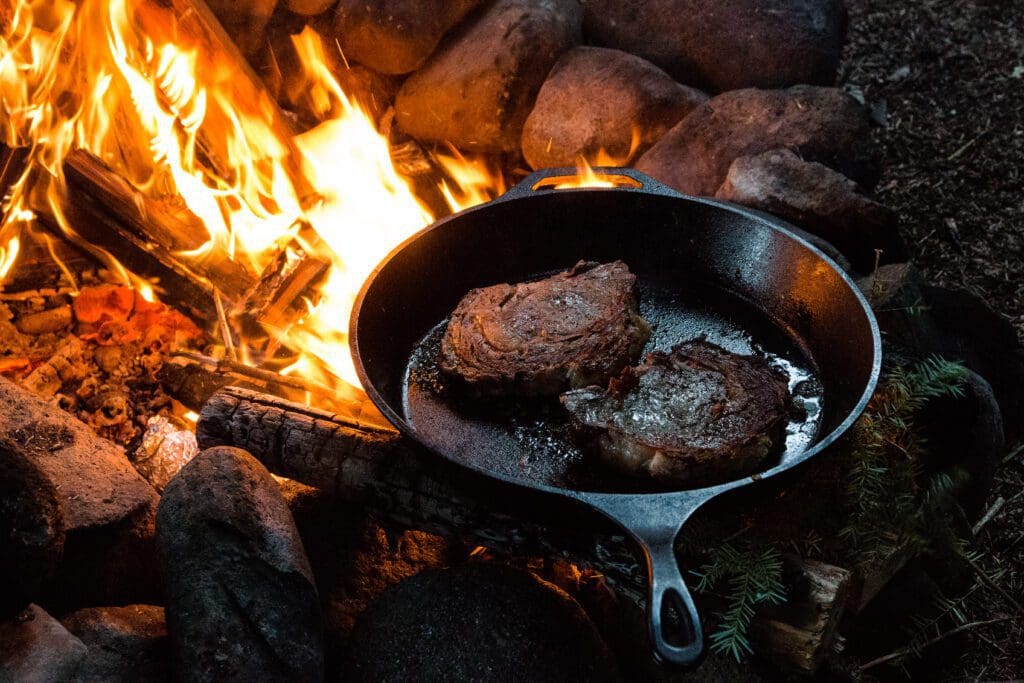
Roast beef is a popular choice for a hearty sandwich for your first lunch on trail and stays relatively cold.
For dinner, consider heating up some chicken kabobs, beef kabobs, or hot dogs over a fire. You can pre-cook these before hitting the trail, and even take them out of the freezer the morning of your hike so they stay colder longer. So get creative on your first night and think about what delicious first-night meats* you’ll have.
*First night meat is totally going to be trademarked by Travel by Rayl.
BONUS: Dehydrated Eggs and Hard Cheeses
Okay I know that dehydrated eggs and hard cheese are not exactly meats for backpacking, but they are great additions to any backpacking meal.
Hard cheeses like cheddar or parmesan can go without refrigeration for longer periods of time. Check out our Best Cheeses for Backpacking article!
Dehydrated eggs are easy to rehydrate and can be combined with pre-cooked bacon, SPAM, or smoked salmon for some pretty great trail breakfasts. Both cheese and dehydrated eggs take up very little space for the flavor they pack.
Dried Cheese Crisps are another great way to add cheesy crunch with little to no carbs.
Sauces and Spices to Pair with Meats for Backpacking.
- Hot Sauce
- Olive Oil
- Garlic Powder
- Soy Sauce
- Nut butters – (nut butter packets or nut butter packs like peanut butter or almond butter)
Sides to Pair with Meats for Backpacking
- Fresh Veggies: (No refrigeration needed)
- Ramen Noodles
- Rice
- Pasta
- Tortillas
- French Bread
- Instant Oatmeal
- Sunflower seeds (added crunch)
- Dehydrated Meals (just add meat!)
- Fresh Fruits
- Freeze-dried fruits
Drinks to Pair with Meats for Backpacking
- Water
- Wine (Anyone else love summit wine?)
- Beer
- Crystal Light
- Tea
- Coffee
- Bourbon
Tips when Carrying Meats for Backpacking
A. Bears
When you’re backpacking in bear country remember…you love your meats for backpacking and bears love your meats for backpacking. To keep both you and the bears safe, store your food properly.
Bear bags are lightweight and can be strung up in trees. Some areas of the country where bears have gotten too clever now require bear canisters. They’re heavy but it’s important to protect your food from the wildlife. On the bright side the bear canisters make a great seat. So check where you’re backpacking to learn the bear requirements.
B. Food Weight
One of the biggest mistakes some backpackers make is to bring too much food. You want enough food to sustain yourself but food weighs a lot. Excess food takes up valuable space and weighs a ton. If you overload on meats for backpacking, you’re not going anywhere.
Consider swapping your cast iron for a lighter frying pan or water-logged foods for their dehydrated brethren. Your back and legs will thank you.
Conclusion
Choosing the right meats for backpacking can make your experience. Meats are high in protein, and usually have a good calorie to weight ratio.
While it can be tempting to bring tons of delicious fresh meat, often the lighter freeze-dried or dehydrated stuff can be almost as good. And you can always add more flavor with spices and harder cheeses. And besides, the trail and a bit of hunger add their own seasoning. You might even have some weight loss.
By making smart choices in your meats for backpacking, you can bring meat camping and still have a safe and delicious camping trip. See you on the Trail!
Read our Best Cheeses for Backpacking post!



